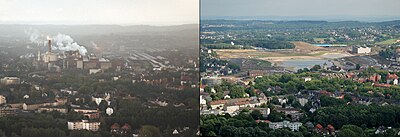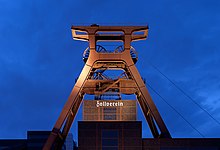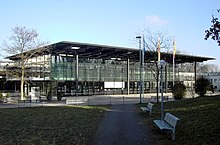Regional structural change

In economic geography, processes that change the components and elements, the competencies and skills as well as the relationships between the components and the infrastructure of a delimited region are referred to as regional structural change. It takes place every day in steps, but becomes particularly visible through drastic breaks in the design of the structure.
Structural change is also a political term, as the requirements for change in a region are set up at all levels of structural policy and then conceptually processed in terms of economic geography. Both scientifically and politically, only proposals and framework conditions can be formulated and created for structural change. Structural change as an economic process itself cannot be controlled in every case. The aim of the political structural change is to regain locational advantages or - in the better case - to maintain and expand them by improving the economic efficiency and differentiation of the region.
Present role
Structural change always plays an obvious and political role when a region or an entire country has structural problems or is considered structurally weak. In the European Union , this applies to the areas of EU expansion to the east , northern Great Britain , southern Italy and - not least - eastern Germany .
The structural weakness of the new federal states in Germany arose politically after the dismantling of market protection. This affected a non-competitive economy. This turning point should be cushioned by transfer payments under the catchphrase “ Aufbau Ost ”. Theories of regional structural change were discussed and applied, particularly with regard to the efficient breakdown and distribution of funds. On the other hand, there is the accusation that state funds were distributed according to the watering can principle , i.e. without a theoretical background.
Since it turned out that the development of the East German regions is not homogeneous, but rather better in individual centers - but worse in many rural regions, 15 years after the start of the transfer payments, a changeover of the principle to the promotion of so-called " lighthouses " is demanded and discussed . The areas around Chemnitz , Dresden , Erfurt , Jena , Leipzig and Rostock as well as the bacon belt around Berlin are viewed as regions with significantly better potential . The problems of the principle of "lighthouse funding" result from the violation of the principle of equality of the Basic Law , in particular against the task of the federal government to "create equivalent living conditions" according to Art. 72 para. 2 GG, whereby it should be noted that a heterogeneous economic structure within a nation can never adhere to the principle of perfect equality in this regard ( see also System of Central Places ).
Causes and Triggers
Various processes are responsible as causes and triggers for structural change. Structural change is rarely caused by a single cause. The causes of regional structural change result from the economic and social competition between regions, which must be accepted. This mutual competition leads to changes in influencing factors. A region has better chances of positive long-term development if it changes continuously and reacts to causes.
Economic causes
General
The most frequent cause of structural change are weaknesses of a region in terms of economic competition with other comparable regions. In this case, the closure of a large company with effects on subcontractors, suppliers and the labor market is often the trigger for a structural crisis and the cause of structural change in the region.
The cause of the weakness can be very different processes and procedures. The reasons for this are, among other things, the lack of renewal of processes and the solidification of structures. Economic success goes hand in hand with rising wages and costs for land and for preliminary products. If the ability to innovate is lacking, there is a risk of a relative loss of quality that no longer justifies the high costs.
In recent years, the change in structures in the search for synergies ( clustering ) and thus cost savings as a means of safeguarding economic location advantages has stood out.
example
The Ruhr area is one of the regions in Europe whose structure was already changed and shaped in early industrialization . Due to the coal mining and the proximity to the open sea (ore supply) an industry of raw material processing developed. These areas in particular have been under enormous competitive pressure for decades, as coal mining in particular has become increasingly uneconomical. Alternative industries developed comparatively late in the automotive and mechanical engineering sectors. Due to a lack of innovation and investment in production facilities, these first replacement industries are also now under pressure from more attractive areas of the world.
Social causes
General
The type and stage of development of a society essentially focuses on the economic sector ( see also: three-sector hypothesis ) of a region. The level of development of a society is roughly divided into agricultural , industrial and information society . The transitions can be very blurry. The important goods are first of all land and labor , later effective and efficient machines as well as information and knowledge . A higher level of development requires more and more globalization , i.e. the worldwide exchange of goods and information as well as the distribution of added value in different regions.
The repercussions of the higher economic sectors on the lower ones are significant for structural change. In practice, this means that an industrial society also has better resources for agriculture. An information society improves your manufacturing industry. In the latter case, one speaks today of the change from an industrial region to a “ high-tech ” region. The change in the social structure of a region creates locational advantages also with the existing means of production and focus. It also follows from this that the share of the gross domestic product of companies in the lower economic sectors in a more developed society in no way disappears.
In order to be able to co-determine and use the transitions of the social form, it has already been shown during the transition to an industrial society that a region needs scientific institutions.
example
The Republic of Ireland, and above all Dublin , had even managed to skip the shape of an industrial society . The country was called the Celtic Tiger because of its enormous economic development (based on the Asian tiger states) . When it was accepted into the European Union , Ireland was still considered structurally weak, but due to massive subsidies from the EU before the financial crisis that began in 2007, it was one of the most dynamic regions in the EU.
The Irish economy managed to export services mainly by building an excellent information infrastructure. This also uses the exposed location between North America and Europe. What was striking about Ireland, however, was that the gross domestic product is significantly higher than the gross national income .
Ecological causes
General
The ecological causes cannot be neglected and often have serious consequences for a region. They are to be found more often than one might initially expect. They often force a total change in the structure of a region. Triggers can be very sudden and unforeseen effects. Here, too, repercussions from developed higher economic sectors can be seen. Early recognition of emerging bottlenecks and risks through a scientific ecological analysis and resource planning helps to better predict such effects.
example
An example of this is the overfishing of a body of water at which the point is reached at some point where a fish population can no longer create enough offspring. This only becomes noticeable when suddenly there are no longer any sufficiently large fish. The cause in this case is an overcapacity of fishing gear and the high efficiency of the fishing.
Since fishing bans are often issued in this case, there is high economic damage in the dependent regions. One possibility for change in this case is the establishment of aquacultures , i.e. the agricultural keeping and breeding of fish, or restructuring for tourism . Since aquacultures require a lot of water because the mass animal populations pollute it, rugged and deep coasts are particularly suitable for aquaculture, such as in Norway . Aquacultures can be automated to a high degree .
Further examples are the death of forests due to monocultures that were established decades ago, or the clearing of rainforest to create (required) arable land that cannot be used in the long term.
Political causes
General
Political measures and changes can also influence structural change. In general, the state tries to regulate change and intervene to steer it. The actually negative form of this is the subsidization of an industry and economic structure that has meanwhile become uneconomical. In the medium term, the state tries to dampen changes that are too rapid, for example to give employees time to switch. If the region fails to adapt, the suspension of the subsidy threatens to trigger a structural weakness.
Other state activities relate to the stimulation of investment and settlement through subsidies. These are, for example, the payment of funds (which may have to be used for a specific purpose), participation in companies and the guarantee for borrowings taken on by investors or, very often as an indirect subsidy, the temporary tax exemption. Since subsidies for investments can be offered by any region, competition takes place in particular through these subsidies. From the point of view of the region, the subsidies should eliminate the advantage in the bundle of location advantages of a competitive region.
Other examples are the opening or closing of borders and the setting or introduction of protective tariffs.
example
The city of Bonn has been the seat of the German Bundestag , the German government and numerous federal authorities since 1949 . As the Bundestag moved to Berlin in 1999 and later the Federal Government, Bonn lost its status as the seat of government and thus its most important economic factor.
Since the decision to relocate the Bundestag, Bonn has been able to distinguish itself as a service location and statistically replace every job. The number of jobs rose by almost 30% or around 22,000 compared to 1991 when the structural change began. Bonn is therefore an example that political causes and actions by the state do not necessarily have to be negative. The change in Bonn was formulated at an early stage, secured through concepts and not suppressed.
Factors
Some properties and requirements influence the course of structural change. Factors can roughly be divided into those that arise by themselves or those that arise through an intervening structural policy .
Existing structure
Regions that have an established structure in several economic sectors appear to be particularly continuously adaptable. The causal relationship between the economic sectors comes to the fore. If this connection is recognizable, it almost automatically leads to the development of the connecting infrastructure and the development of further elements. For example, Frankfurt is in a very favorable topographical location in Central Europe. Its importance as a logistics center was followed by its importance as a market and financial market location . The latter are closely related to information goods , which in turn can be recorded as logistical goods . This also resulted in an excellent information infrastructure in Frankfurt. Structural change takes place much easier and more continuously in such regions. Changes happen because of an economic necessity .
Competence development and development
Research and higher education institutions have been a factor that has helped a region to position itself and develop favorably , particularly since early industrialization . This factor is all the more important in the current development of globalization, since the proportion of product development compared to production has increased enormously in the total value added . This includes the way in which knowledge is distributed among the population.
It is also possible and cheap for a region if it forms a core competence that it can develop further over decades. It also favors the continuous change in the structure. Examples of areas and regions with pronounced core competencies are, for example, the Stuttgart region in vehicle and aircraft construction or the Dresden and Erfurt regions in the development of electrical engineering and microelectronics .
Infrastructure change
In order to trigger successful structural change, a region must adapt the existing infrastructure to the new goods and goods. Infrastructure is a prerequisite for allowing distributed value chains in and across the region. Infrastructure is the point at which economic policy often starts, especially because the effectiveness of measures is more predictable than when developing and building skills.
Problems
Regional structural change, especially if it happens quickly and suddenly, causes numerous problems. Structural change, however, in relation to one's own residential region or other regions, is only perceived where it is accelerated and thus more easily perceptible. Because of this perception, structural change triggers fears in many people.
The problems of structural change particularly affect the residents of the region. In particular, there are social , psychological and economic repercussions on the people affected.
If structural change occurs together with rationalizing measures such as automation , workers are laid off and thus unemployed. This problem is often very protracted, especially after rapid structural changes. Even if the region maintains its competitiveness through such measures, there is a different allocation of the acquired resources in the region . Changes to the region's domestic economy can result if general purchasing power falls.
The competitive pressure to which a region is exposed is transferred directly to the people in a region. Ultimately, residents of a region must be able to follow the change, which is not possible for everyone, especially for social, physical and psychological reasons. Being able to follow the change personally means in particular gaining knowledge of new elements of the regional structure and being able to deal with new technologies. Adapting one's own skills is a prerequisite for participating in change. As a result, people who have built up educational deficits in the face of rapid structural change are more difficult to integrate into the changed economic structure.
Another problem of structural change concerns the aftermath of a negative trigger, for example the dissolution of a core competence-bearing industry in a region. A region can react against the resulting problems with its regional marketing. The consequences of the problem are a loss of image, which makes it more difficult to encourage new investments and the emigration of skilled workers.
See also
- globalization
- Structural change (disambiguation page)
- social change
literature
- Fabian Bross (2008): The expansion of the retail trade with special consideration of the effects on urban development in Germany, Bavaria and Munich in the 60s, 70s and 80s . In: Aventinus. The historical internet magazine by students for students, issue 05.
- Jürgen Dispan, Ralf Grammel, Frank Iwer, Sylvia Stieler: Structural change and regional cooperation. Work-oriented structural policy in the Stuttgart region . Marburg 2002.
- Michael Beer (2008): Bavaria's boom in farming. State planning and structural change in the Bavarian economy in rural areas from 1945 to 1975. Lulu, Morrisville, ISBN 978-1-4092-0580-7 .
- Wolfgang Cornetz, Stefan Hell, Peter Kalmbach, Holger Schäfer: Chances and Risks of Demographic and Structural Change in Saarland. On the importance of the key variable human capital . Saarbrücken: universaar 2010, ISBN 978-3-86223-000-6 .
- Luitpold Rampeltshammer, Hans Peter Kurtz (Ed.): Structural change in the Saarland. Challenges and design options . Saarbrücken: universaar 2011, ISBN 978-3-86223-008-2 .



